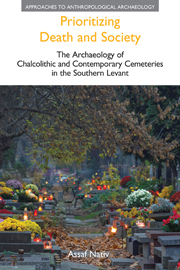 Prioritizing Death and Society
Prioritizing Death and Society Book contents
- Frontmatter
- Dedication
- Contents
- List of figures
- List of tables
- Acknowledgements
- Part I Introduction
- Part II Chalcolithic cemeteries
- 3 Chalcolithic cemeteries: winks, twitches and faked twitches
- 4 Isolated in the landscape: single-cave cemeteries
- 5 Multiple components: multiple-cave cemeteries
- 6 Dark, damp and deep: karstic-cave systems
- 7 Funerary structures
- 8 Exceptions, outliers and misfits
- 9 Structured deposition and depositional structures
- Part III Contemporary cemeteries
- Part IV Conclusion
- Appendix: Gazetteers of cemeteries
- Notes
- Bibliography
- Index
8 - Exceptions, outliers and misfits
from Part II - Chalcolithic cemeteries
- Frontmatter
- Dedication
- Contents
- List of figures
- List of tables
- Acknowledgements
- Part I Introduction
- Part II Chalcolithic cemeteries
- 3 Chalcolithic cemeteries: winks, twitches and faked twitches
- 4 Isolated in the landscape: single-cave cemeteries
- 5 Multiple components: multiple-cave cemeteries
- 6 Dark, damp and deep: karstic-cave systems
- 7 Funerary structures
- 8 Exceptions, outliers and misfits
- 9 Structured deposition and depositional structures
- Part III Contemporary cemeteries
- Part IV Conclusion
- Appendix: Gazetteers of cemeteries
- Notes
- Bibliography
- Index
Summary
The four preceding chapters offered a fairly detailed survey of four types of cemeteries used during the Chalcolithic period of the southern Levant. Together they account for the great majority of known cases and offer an answer to the confusing variability that has hindered the crystallization of a deeper understanding of these phenomena. Yet, every rule has its exceptions; every perceived order has its incompatibilities. And, indeed, alongside the many cemeteries that are readily assigned to one category or another, one cannot escape noting several that do not fit, either because they defy an elemental principle that characterizes other cemeteries in their vicinity, or because they seem to present a class that is unprecedented altogether.
No account of Chalcolithic cemeteries is complete without acknowledging these cases. It is thus the aim of this chapter to present these cases and offer as good an account of their peculiarity/singularity as possible. Each of these will be discussed separately and their qualities compared to the now hopefully better-established categories. However, the degree of success varies and depends upon the extent to which the variations can be attributed to structural features or contingent circumstances. Their order of presentation will progress roughly from north to south.
Sha'ar Efrayim
The cemetery of Sha'ar Efrayim is located in the Sharon Valley, east of the eponymous modern community.
- Type
- Chapter
- Information
- Prioritizing Death and SocietyThe Archaeology of Chalcolithic and Contemporary Cemeteries in the Southern Levant, pp. 112 - 119Publisher: Acumen PublishingPrint publication year: 2013


